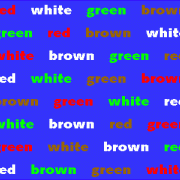In a recent study 96 people with Alzheimer's disease and 40 healthy people were interviewed. All the participants were about the same age and came from the same social and cultural backgrounds.
They were first asked to:
- name all the animals they could think of in one minute
They were then asked to:
- name all the types of fruit they could remember in one minute
The researchers found that people with early Alzheimer's were able to list only 10 to 15 words in contrast to the 20 to 25 words in the healthy group.
The Relationship Between Word Recall and Alzheimer's
- During childhood we learn words at different ages. Words like cat and dog are learned before the age of 5 years whereas words like giraffe and zebra are learnt later on and used less frequently. In the study, people in the early stages of Alzheimer's consistently forgot words they learned later in their lives. The researchers found that the pattern of word loss was so consistent that they could identify people with Alzheimer's on their word 'loss' alone.
- No reliable clinical methods can yet determine cognitive decline due to normal aging or Alzheimer's. One of the interesting features of this simple word task is that it involves a part of the memory system in the brain not currently tested by diagnosticians. It may well be that the part of the brain in which this word loss is identified is also the part of the brain that gets most affected in the early stages of Alzheimer's disease.
- The researchers are looking towards developing a new test that helps with early diagnosis of Alzheimer's that are not currently available.
- Implication for early diagnosis of Alzheimer's
- Improved diagnostic screening for early Alzheimer's has a number of benefits.
- Early diagnosis allows people in the early stages of the disease to contribute to the decision making process about medication.
- Existing medications work best, if they are going to work at all, in the early stages of Alzheimer's. Early detection allows early intervention. As medications are developed it could well be that in the future early detection will prevent the irreversible damage to the brain that occurs as Alzheimer's progresses.

The Stroop test, also referred to as the Stroop Color Word Test or the Stroop Effect, is a test dating back to the 1930’s that measures cognitive functioning. It may be used as part of the assessment process when conducting an evaluation to determine if someone has mild cognitive impairment, Alzheimer’s or another type of dementia.
The Stroop test is considered by some to be an effective measure of executive functioning, the ability to plan, apply knowledge and make decisions.
Executive functioning, along with short term memory impairment, is often one of the symptoms of early stage Alzheimer’s disease.
The Stroop effect was first written about by John Ridley Stroop in 1935 for his Ph.D. dissertation.
What Does the Stroop Test Contain?
- The Stroop Test consists of colors that are written in words but in the wrong color ink. The test-taker has to be able to state the color that the word is written in and be able to ignore whatever the actual word is. For example, if you see the word “red” but it’s written in blue ink, the correct answer would be “blue”.
Stroop Test Results
- Older adults who do not have any cognitive impairment have, on average, a slower response time than younger and middle-age adults, but they typically answer the questions correctly.
- People with mild cognitive impairment, Alzheimer’s or another dementia, on the other hand, will be slower in answering but also will have a significantly higher rate of incorrect answers because of their decline in processing information and the inability to ignore one stimulus (the word) while focusing on the other one (the color).
What Does the Stroop Test Identify?
- The Stroop Test has been associated with impairment specifically in the prefrontal cortices of the brain, especially in earlier stages of Alzheimer’s. As Alzheimer’s progresses into the middle and late stages, the Stroop effect is not a valid indicator of the location or extent of impairment in the brain.
Variations of the Stroop Test
- Variations of the Stroop Test have been developed and tested recently, particularly with the goal of assessing executive functioning early in Alzheimer’s. Rather than continue the same set of directions throughout the test, the new version required the participants to switch back and forth between two different sets of directions.
- For example, on one section of the test, they might have to identify the color the word is written in, and in another section of the test, they might have to read the word and ignore the color that the word is written in.
- Other variations might include a written word that is not a color, such as the word "five" in a certain color ink.
How Accurate Is the Stroop Test in Identifying Mild Cognitive Impairment or Early Alzheimer’s?
- In one study conducted by Hutchison, Balota and Duchek, variations of the Stroop Test (which involved switching the directions as described above) were better than 18 other typical cognitive tests at differentiating between healthy older adults and those with early Alzheimer’s.
References:
- Dementia and Geriatric Cognitive Disorders EXTRA. 2011 Jan-Dec; 1(1): 190–201. Neural Correlates of Stroop Performance in Alzheimer's Disease: A FDG-PET Study. http://www.ncbi.nlm.nih.gov/pmc/articles/PMC3199888/
- The Environmental Psychology Lab. School of Natural Resources and Environment, University of Michigan. Stroop Effect. http://www.snre.umich.edu/eplab/demos/st0/stroopdesc.html
- National Institutes of Health. National Institute on Aging. Developing New Cognitive Tests. http://www.nia.nih.gov/alzheimers/publication/6-advances-detecting-alzheimers-disease/developing-new-cognitive-tests
- Psychology and Aging. 2010, Vol. 25, No. 3, 545–559. The Utility of Stroop Task Switching as a Marker for Early-Stage Alzheimer’s Disease. http://www.scribd.com/doc/283607773/The-Utility-of-Stroop-Task-Switching-as-a-Marker-for-Early-Stage#scribd






